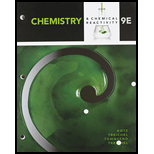
Concept explainers
Three resonance structures are possible for dinitrogen monoxide, N2O.
- (a) Draw the three resonance structures.
- (b) Calculate the formal charge on each atom in each resonance structure.
- (c) Based on formal charges and electronegativity, predict which resonance structure is the most reasonable.
(a)
Interpretation:
The three resonance structure of
Concept Introduction:
Resonance structures: A molecule or ion which show more than structure but none of them are accurately correct show the known property of that molecule, and can lie between the canonical structure is known as resonance or canonical or contributing structure.
Explanation of Solution
The three resonance structure is drawn

(b)
Interpretation:
Formal charge on each atom in each resonance structure has to be calculated.
Concept Introduction:
Formal charge: It is the electrostatic charge that would reside on an atom in a molecule or polyatomic ion if all bonding electron are shared equally between pairs of atoms.
Formal charge calculation: The formal charge for atom in a molecule or ion is calculated based on the Lewis structure of the molecule or ion by following the given equation below:

 - Number of valence electrons
- Number of valence electrons
 - Number of non-bonding electrons
- Number of non-bonding electrons
 - Number of bonding electrons
- Number of bonding electrons
Explanation of Solution
The formal charges can be calculated as follows.
For resonance structure A is given below,

Formal charge on nitrogen
Formal charge on nitrogen
Formal charge on oxygen can be calculated as follows.
For resonance structure B is given below,

Formal charge on nitrogen
Formal charge on nitrogen
Formal charge on oxygen can be calculated as follows.
For resonance structure C, is given below,

Formal charge on nitrogen
Formal charge on nitrogen
Formal charge on oxygen can be calculated as follows.
(c)
Interpretation:
From the resonance structure drawn, the most reasonable structure has to be identified.
Concept Introduction:
Formal charge: It is the electrostatic charge that would reside on an atom in a molecule or polyatomic ion if all bonding electron are shared equally between pairs of atoms.
Formal charge calculation: The formal charge for atom in a molecule or ion is calculated based on the Lewis structure of the molecule or ion by following the given equation below:

 - Number of valence electrons
- Number of valence electrons
 - Number of non-bonding electrons
- Number of non-bonding electrons
 - Number of bonding electrons
- Number of bonding electrons
Resonance structures:
A molecule or ion which show more than structure but none of them are accurately correct show the known property of that molecule, and can lie between the canonical structure is known as resonance or canonical or contributing structure.
Explanation of Solution
The three resonance structure is drawn

- (a) The formal charges can be calculated as follows.
For resonance structure A

Formal charge on nitrogen
Formal charge on nitrogen
Formal charge on oxygen can be calculated as follows.
For resonance structure B

Formal charge on nitrogen
Formal charge on nitrogen
Formal charge on oxygen can be calculated as follows.
For resonance structure C

Formal charge on nitrogen
Formal charge on nitrogen
Formal charge on oxygen can be calculated as follows.
Thus from the formal charge given above, the Structure B is most reasonable

Want to see more full solutions like this?
Chapter 8 Solutions
Bundle: Chemistry & Chemical Reactivity, Loose-Leaf Version, 9th + OWLv2, 4 terms (24 Months) Printed Access Card
- Write all resonance structures of chlorobenzene, C6H5Cl, a molecule with the same cyclic structure as benzene. In all structures, keep the CCl bond as a single bond. Which resonance structures are the most important?arrow_forwardFor the carbonate ion (CO32-), there are 3 resonance structures. For any given structure what would the formal charge be for an oxygen that has a single bond to the central carbon atom?arrow_forwardThe thiocyanate ion , NCS- , has three possible Lewis structures.a. Draw these three structures and assign formal charges in each.b. Which Lewis structure is dominant?arrow_forward
- Write a Lewis structure for the amide ion, NH2─, and assign formal charges to each atom.arrow_forwardWrite a Lewis electron dot diagram for phosphoryl chloride,POCl3 (Fig. 3.29). Assign formal charges to all the atoms.arrow_forwardDraw the Lewis structure for the nitrate ion, NO3-, with formal charges on each atom and resonance structures.arrow_forward
- The cyanate ion, NCO– , has three (3) possible Lewis structures. (a) Draw these three structures and assign formal charges in each. (b) Which Lewis structure is dominant?arrow_forwardWhat is the formal charge on carbon in COCl2?arrow_forwardBoth aluminum and iodine form chlorides, Al₂Cl₆ and I₂Cl₆ ,with “bridging” Cl atoms. The Lewis structures are (a) What is the formal charge on each atom? (b) Which of these molecules has a planar shape? Explain.arrow_forward
 Chemistry: Principles and PracticeChemistryISBN:9780534420123Author:Daniel L. Reger, Scott R. Goode, David W. Ball, Edward MercerPublisher:Cengage Learning
Chemistry: Principles and PracticeChemistryISBN:9780534420123Author:Daniel L. Reger, Scott R. Goode, David W. Ball, Edward MercerPublisher:Cengage Learning Chemistry: Principles and ReactionsChemistryISBN:9781305079373Author:William L. Masterton, Cecile N. HurleyPublisher:Cengage Learning
Chemistry: Principles and ReactionsChemistryISBN:9781305079373Author:William L. Masterton, Cecile N. HurleyPublisher:Cengage Learning

